How to Calibrate a Drone Compass for Smooth Flights
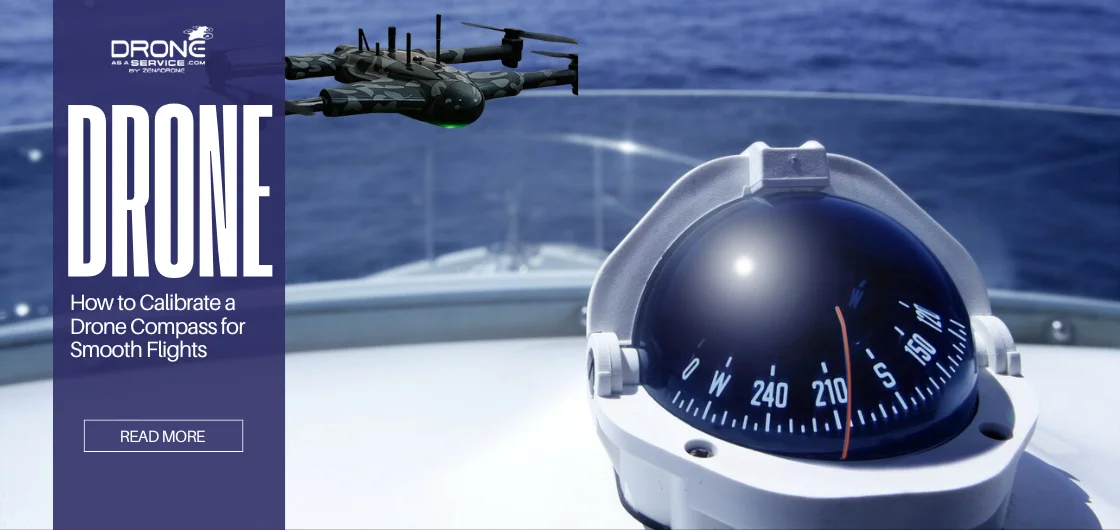
Every successful drone flight begins with having stability and accuracy, which both depend on the drone’s compass calibration.
The drone’s directional guidance is provided by the compass and lets it understand its orientation relative to Earth’s magnetic field. If it’s calibrated, the drone can navigate smoothly while maintaining balance and communicating correctly with GPS signals.
The crucial step for your drone is the calibration, since without this, the drone may drift off course, rotate unexpectedly, or display navigation errors. Even if you’re a professional pilot or just into drone flying, calibrating your compass just before flight performance will make your drone more accurate, safer, and thus keep your aircraft operating better.
In this blog, we will explore how drone compass calibration helps in achieving smooth, precise, and confident drone operations for your business. Also, you will explore how Drone as a Service (DaaS), an expert in the drone industry, provides calibration and flight maintenance solutions.
Why Compass Calibration Matters for Drones?
The compass of the drone is the main internal navigation system, and is responsible for keeping the drone properly oriented according to the magnetic field of the Earth. This ensures that the drone maintains balance during the flight and knows which direction it’s facing.
When drone compass calibration is performed incorrectly and is skipped, the drone can easily lose its sense of direction. When problems like this occur, it leads to erratic movements, drifting, unexpected rotations, or even losing control. This kind of issues affects the flight quality but also put the drone at risk for crashing.
The inaccurate compass data also causes GPS mismatches, where the drone receives conflicting information about the heading and location. The errors can result in poor navigation, unstable positioning, or flyaways. Having proper calibration, the drone can be used effectively with GPS satellites, ensuring that it has accurate positioning and control while flying.
The drone’s GPS calibration helps drone pilots improve safety in flight and reduce the related risks, and enhances overall reliability. Having a well-calibrated drone not only improves drone efficiency but also provides accurate data, especially during flights.
Signs Your Drone Compass Needs Calibration
Understanding when to calibrate your drone compass is needed to maintain the accuracy, stability, and flight safety of the drones. A misaligned compass can cause the drone to behave unpredictably, making drone compass calibration an important step before takeoff. Here are some of the signs.
Unusual rotation
Your drone keeps turning very erratically and seems to be having a hard time getting a single line. It’s time to calibrate the drone compass.
Tilting or Drifting
The drone tilts toward one side or drifts on its own without wind, indicating a problem with the self-fly calibration of the drone’s navigation systems.
Unstable hovering
You get a lot of trouble in holding a position, which means it can be caused by some interference with your readings through the compass.
GPS errors
The drone has GPS errors due to a poor satellite signal or incorrect location tracking by its penetration sensor; hence, GPS calibration is required.
Fluctuating Altitude
The aircraft suddenly rises or dips during flight, indicating a misaligned compass or sensor.
Control loss or delayed responses
The drone disregards commands, as evidenced by significant lag between commands and action; thus, your entire drone-flying calibration needs to be redone.
If these signs are neglected, they lead to too many flight instabilities and sometimes accidents. Regular calibration of the compass makes your flight more stable and smooth, making it more accurate and safe while flying.
Preparing Your Drone for Calibration
Before beginning any drone flight calibration, proper preparation is essential to ensure smooth results. The environment and equipment help the drone perform.
These are the key steps before you calibrate your drone compass for more effective drone solutions:
- Charge your drone completely: A low battery charge interrupts the programming process of the compass, causing an interruption to be within performance interruption.
- Choose an open area with no interference: Keep well clear of vehicles, fences, power lines, or other objects that may be magnetic and capable of disrupting the calibration process of the drone navigation.
- Remove all metallic accessories: Metal phone holders, jewellery, or any such metal will interfere with your drone’s magnetic readings.
- Do not calibrate indoors: Indoors, there are always hidden magnetic materials that would affect the accuracy of the calibration between the GPS of the drone.
- Update the firmware: Check for available downloads and have your new version set before you start calibrating.
Having a clean, open, and magnetically neutral space is ideal for calibration, making it the most suitable environment for drone calibration in flight.
Doing careful preparation of one’s equipment reduces most mistakes, gives more stability to the flight, and ultimately, best performance.
Step-by-Step Guide to Calibrating a Drone Compass
The calibration that is properly made can be the foundation of drone performance. For businesses that rely on drones for surveying and inspections or even aerial monitoring, having a step-by-step guide to calibrate your drone compass accurately ensures stable operations and solutions:
- Activate your controller and drone: Switch on the drone and connect it to the appropriate controller or mobile application.
- Go to the calibration menu: Wait until the point where the drone compass calibration starts, whether it be the compass or the waypoint settings.
- Follow the instructions as indicated on the display or manual: Most commonly, drones involve a rotation-spinning motion; the drone needs horizontal and vertical spins.
- Rotate the drone gradually and equally: This will help the sensors collect consistent data from the magnetic field and accurately calibrate drone navigation.
- Wait for a success indication: Your calibration is now finished when the app or the controller produces a success sign.
- Do a short test flight: After calibration, test your drone to see if it hovers stably and accurately points in the same direction.
Having the drone compass calibrated saves time for good navigation reliability, flying accuracy, and increases efficiency, critical precision for those businesses that require it.
Calibrating the Drone Compass in Different Models
The different drone models have different steps to calibrate the drone compass, so using specific instructions for each brand may help in reliability and precision. Here are some ways to calibrate the drone compass for ZenaDrone’s drone models available:
Zenadrona 1000
The compass calibration is found through the dedicated control app and select “Compass Calibration”. The model features sensitive magnetic sensors; it’s important to avoid metallic surroundings or reinforced concrete while calibration takes place. Because of the precision design, the interference can have a great effect on the reading.
IQ Nano
This offers a simplified process ideal for less-experienced pilots. Using the app or controller, you can select “Calibrate Compass” and then follow the instructions to rotate the drone. If confirmed, GPS alignment and magnetic should be restored.
IQ Square
This requires synchronized calibration with the hybrid GPS+ compass system. You can access the calibration menu in the interface, then rotate the drone until the compass indicators and GPS confirm. The procedures may also be different for the firmware updates.
For other drones, it may need to be calibrated differently due to the software version and configuration differences. So you’d better be reading the official manual from the manufacturer or their homepage to know how to calibrate the GPS of your drones.
Troubleshooting Compass Calibration Errors
Even if you carefully prepare, the drone compass calibration may unexpectedly fail. These errors are common and usually caused by software glitches, magnetic interference, or even the device itself.
For businesses that need drone solutions for precise tasks, understanding how to troubleshoot calibration issues is essential to maintain the reliability and accuracy.
- Change your location: The magnetic-interference effect that vehicles, buildings, or power lines introduce can skew readings in outdoor settings. Easy to reduce interference and calibrate your drone navigation with improved results.
- Restart the controller and drone: Rebooting the power on the drone and controller will temporarily clear any possible software errors that might interfere with calibration.
- Repeat the process of calibration: Performing a minimized flight calibration again sometimes realigns the sensors properly.
- Examine drone settings: Use the control app to view any error codes or prompts about calibration or compass issues.
- Recalibrate after updates and travel: Re-calibration should be performed whenever updates or new travels are undertaken. GPS calibration should always be done after firmware updates or when flying in a new area, as magnetic conditions differ from region to region.
- Consistent Checking: Regular troubleshooting and maintenance ensure that your drone flies well, minimizing downtime and maximizing accuracy.
Drone GPS Calibration vs. Compass Calibration
It is necessary to understand that UAV GPS calibration is a different thing from UAV compass calibration. The importance of both is determined for the effective functioning, but their requirements are different:
- Compass calibration of the compass means that the alignment of the orientation that your drone takes depends on the alignment of the Earth’s magnetic field and how it might sway direction.
- Drone GPS calibration is compatible with interoperating with satellite location data for occupying that precise place.
When combined, they eliminate navigation error, drift, and flight paths that are made unstable. Businesses must recalibrate drone navigation during any move to a new flying environment, following any firmware updates, and if the drone is showing some inconsistencies in producing the location data.
This simultaneous calibration of the compass and GPS will eventually ensure high calibration accuracy for drone flight, minimizing data errors and improving operational efficiency in the field.
Best Practices for Flying Drones Smoothly
To ensure a drone operates in peak performance, and also avoids errors for navigation. These practices are important in ensuring the best possible drone flights according to your needs:
| Practice | Purpose / Benefit |
|---|---|
| Drone Compass Calibration | Calibrate the compass before every flight to enhance orientation accuracy and prevent drifting or navigation errors caused by magnetic interference. |
| Drone GPS Calibration | Ensures precise positioning and consistent tracking throughout the flight, improving navigation reliability. |
| Complete Navigation Calibration | Combines GPS and compass adjustments to boost flight stability, efficiency, and overall drone performance. |
| Fly in Open Areas | Choose wide, clear spaces to minimize interference from buildings or metal structures and maintain strong signal strength. |
| Avoid Zones with Distractions | Stay away from large metal objects, power lines, and vehicles that may affect magnetic sensors or GPS accuracy. |
| Perform Short Test Flights | Conduct a brief test flight after calibration to verify sensor accuracy and drone stability before complex operations. |
| Proper Drone Storage | Store the drone away from electronics, high heat, and magnetic fields to protect sensors and maintain long-term performance. |
Conclusion
Proper drone compass calibration is the foundation of precise, safe, and stable drone flying. This ensures that the drone stays on course and the GPS connection remains strong. Whether you are using a Zenadrona 1000, IQ Nano, or IQ Square, knowing how to calibrate your drone compass helps you and your business.
At Drone as a Service (DaaS), we make and support drones with high performance, whether for professionals or anyone else flying. Added to that, the new advanced calibration technology makes drone flying easier for each takeoff and every mission safe.
Read Our Other Blogs
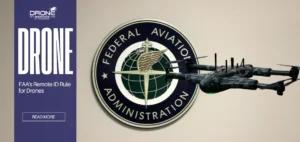
14 November 2025
FAA’s Remote ID Rule for Drones
FAA’s Remote ID Rule for Drones Drones have evolved from hobby gadgets to essential tools in agriculture, construction, security, and...
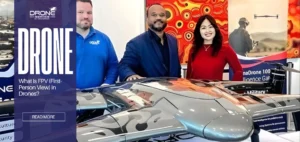
13 November 2025
What is FPV (First-Person View) in Drones?
What Is FPV (First-Person View) in Drones? FPV (First-Person View) drone flying allows pilots to experience flight directly from the...

12 November 2025
How to Calibrate a Drone Compass for Smooth Flights
How to Calibrate a Drone Compass for Smooth Flights Every successful drone flight begins with having stability and accuracy, which...
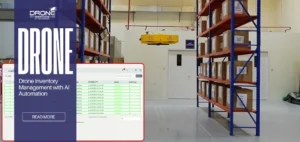
10 November 2025
Drone Inventory Management with AI Automation
Drone Inventory Management with AI Automation Manual inventory tracking is slow, costly, and prone to errors. Employees must climb ladders,...

07 November 2025
Drones for Emergency Response & Disaster Relief
The Best Autonomous Drone Companies in the World Disasters are a matter of time. Floods, fires, and earthquakes all require...
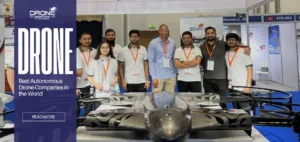
06 November 2025
The Best Autonomous Drone Companies in the World
The Best Autonomous Drone Companies in the World The United States is home to some of the best autonomous drone...


















